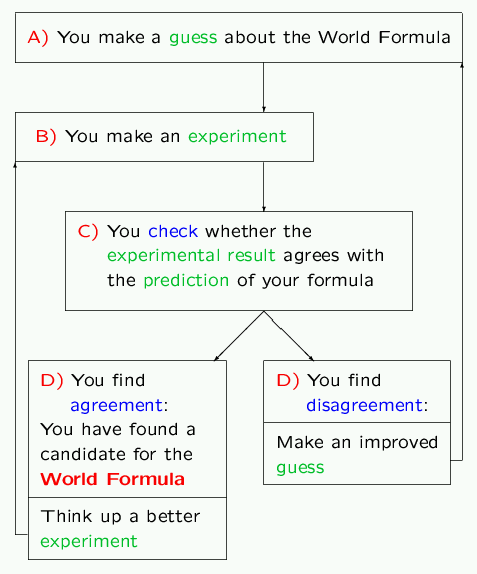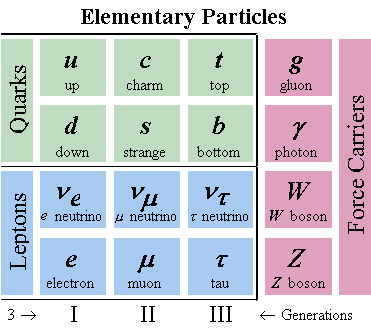The Quest for the World Formula/Theory of Everything
-
What is a World Formula?
The World Formula is a mathematical description of the smallest components of matter (often called "elementary particles"). Besides describing the smallest component of matter, it also contains the information about their "interaction", i.e. what these smallest components do to each other.
Below there is an example of a small piece of the World Formula in our current understanding (the World Formula is often called "L"):The formula describes an electron (labeled "e-") that emits a photon (a particle of light), labeled with "gamma"). The electron does not change its nature while emitting the photon, but it stays an electron. What the formula describes is also depicted right below: an electron comes from the left, emits a photon, but stays an electron. This is actually the experimentally observed behavior of electrons and photons. It happens e.g. if a light bulb shines. Its just electrons emitting photons.
-
Is it clear that a World Formula exists?
No, this is not clear. However, the history of physics has shown us that a mathematical description of nature is possible. Therefore it is a common believe and hope that something like the World Formula exists. Looking back at the history of physics, one can see the following important steps towards something like the World Formula:
- In the beginning, physicists discoved gravity, and somewhat later electricity. It has been found that they can be described with the same type of formula (but not really the same one).
- Electricity and magnetism were discovered centuries ago. Later it was found that they are actually two aspects/versions of the same thing, i.e. they are described by the very same Formula (now called "electromagnetism").
- Later electromagnetism and another force found in nature (see below) were found to be described by the same Formula.
-
How can we find the World Formula?
A formula describing nature can be found in the following way:

In this way (in step D/agreement) a more and more advanced version of the World Formula is being found.
-
What do we know about the World Formula so far?
Particle physicists have a quite good guess already about a World Formula. It is a mathematical formula that describes all known smallest particles (the "elementary particles") and what they do to each other (the "interaction"). This formula is called the "Standard Model" of particle physics.
The World Formula so far describes
- The smallest components of matter (elementary particles), the
so called quarks and leptons.
- There are six quarks in our world, called d, u, s, c, b, t quark.
- And there are six leptons in our world, too, called e, mu, tau, e neutrino, mu neutrino, tau neutrino.
- The particles responsible for the force, the "interaction" of the
matter particles. These are
- the photon (responsible for the light, the electromagnetic force)
- the W and the Z particle (responsible for radioactive decay)
- the gluon (responsible for holding the u and d quarks together in the protons and neutrons that make up the atomic nucleus)

- But the World Formula contains one more piece: a mysterious particle that is needed to make the whole formula work, the Higgs particle (named after its "inventor", Peter Higgs). It is the Higgs particle that makes the other particles massive. If it would not exist, the World Formula could only describe particles with zero mass.
These are all the components of our current version of the World Formula. It then looks something like this:
- The first piece again describes an electron emitting a photon.
- The second piece describes an u quark emitting a W. Here the u quark changes its nature (as has been observed in experiments) and becomes a d quark.
- The third piece describes the interaction of a W with the Higgs particle.
- The ellipses show that our current version of the World Formula is actually somewhat longer.
The one missing piece of the World Formula is the Higgs particle. This particle is probably the most searched particle in the world, it leads the "most wanted" list. Many physicists, involved in big high energy experiments, are looking for traces of this particle. However, so far they have not been successful. But the search goes on right now at Fermilab (in Batavia, IL, USA). The search will then be continued in 2007 at the CERN laboratory, Geneva, Switzerland.
This machine will either find the Higgs particle or rule out its existence. In the first case, we would know that our current guess about the World Formula was quite good. In the latter case, we would have to make a quite new guess about the World Formula.
- The smallest components of matter (elementary particles), the
so called quarks and leptons.
-
An improved guess about the World Formula: Supersymmetry
It is a common believe that our current version of the World Formula is not the ultimate one. There are several reasons:- Gravitation is not included.
- The Formula contains many (too many?) "free parameters". (A "free parameter" is a constant parameter in the formula whose value can only be determined in an experiment, but cannot be derived from the formula itself.)
- Why are there so many quarks and leptons?
- How and why does the Higgs particle work?
- What is the Dark Matter made of that has been observed by the astronomers in space? (To be more explicit: astronomers have observed the movement of galaxies that can only be understood if there is about 10 times "more" than the galaxies itself. This "more" must be some kind of particles that we do not know yet. It is not contained in the stars or the planets. It must be spread throughout the space; and it is not described by our World Formula - yet.)
If the world would be supersymmetric, it would contain
- SUSY partners to all quarks and leptons, called s-quarks and s-leptons.
- SUSY partners to all force particles
- SUSY partners to the Higgs particle
- not one Higgs particle, but at least five of them
None of the SUSY partners have been observed so far. (Because they are too heavy?) But these particles are being searched for right now at Fermilab (in Batavia, IL, USA). The search will then (as for the Higgs) be continued in 2007 at the CERN laboratory, Geneva, Switzerland. If SUSY is the right way to the ultimate World Formula, we will learn about it within the next 6 or 7 years.
-
How are we advancing the World Formula right now?
Particle physicists all over the world are currently working on improving the World Formula.- Some physicists are searching for the Higgs or the SUSY particles (at Fermilab or the CERN laboratory, see above). They try to figure out what guess for the World Formula is correct.
- Some others are trying to make new guesses of how a more advanced Formula might look like and what their consequences could be (e.g. new particles that can be searched for).
- From time to time physicists from all over the world gather at a conference, a big meeting and discuss their new findings.
- New results are made public. They are presented at the conferences and printed in journals.
Introduction
The ultimate goal of particle physics is to discover the World Formula.
LMU Munich, Germany
Sven.Heinemeyer@cern.ch